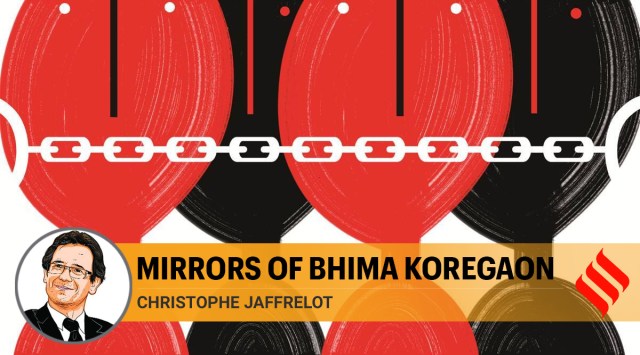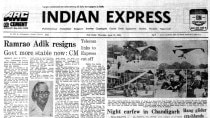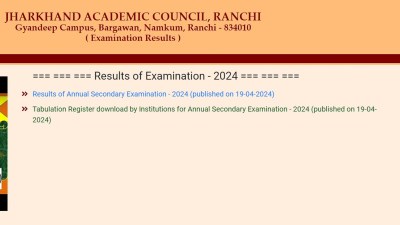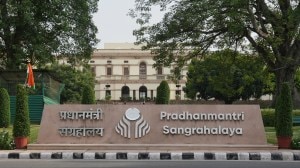- India
- International
Arrests in Bhima Koregaon case frame a transformation in India’s polity and police force
The current usage of the expression "urban Naxal" owes much to Bollywood film director Vivek Agnihotri, who defines an “urban Naxal as an intellectual, influencer or activist who is an invisible enemy of India”. The idea of such a conspiracy was propagated, however, by the Sangh Parivar.
 The expression ‘urban Naxals’ allegedly designates urban Maoists, in contrast with those in rural India. (Illustration by C R Sasikumar)
The expression ‘urban Naxals’ allegedly designates urban Maoists, in contrast with those in rural India. (Illustration by C R Sasikumar)On October 23, Stan Swamy, an 83-year old Jesuit priest, was sent to judicial custody in the Bhima Koregaon case. His is the latest arrest in a case that illustrates a significant transformation in India’s polity and the country’s police force.
Bhima Koregaon is a village in Maharashtra’s Pune district where, in 1818, Dalit soldiers of the British army, mostly Mahars, trounced the troops of the local ruler, Peshwa Bajirao II, a Brahmin. On January 1, 2018, like every year, Dalits of Maharashtra, mostly Mahars, gathered to commemorate this event. On the eve of the event, an Elgar Parishad (“Congress for Speaking Aloud”) in Pune, whose organisers included two retired judges, saw speakers contesting “homogenising Hindutva” and criticising the Narendra Modi government. The police allege that this was the provocation for violence at Bhima Koregaon — participants of the event were attacked by upper-caste Hindu nationalists. They retaliated, leading to the death of one person.
A Dalit activist filed a complaint against two men, Sambhaji Bhide, who had past links with the Sangh Parivar, and Milind Ekbote, a former BJP corporator who had been jailed several times — on one occasion, for participating in a communal riot. The latter went to jail briefly, but the police, in spite of the report showing both men guilty of “a well-planned conspiracy,” began looking at a different angle after a disciple of Bhide, Tushar Damgude, filed a complaint.
This shift took place while the Pune-based Forum for Integrated National Security — seen as close to the RSS — was putting forth the notion of a Maoist conspiracy. Soon after, the police made new arrests — the accused were presented as “urban Naxals”.
Opinion | Harsh Mander writes: Stan Swamy has stood with the oppressed. The state considers him an enemy

The expression “urban Naxals” designates alleged urban Maoists — in contrast with those in rural India, particularly the country’s tribal areas, which are the crucible of the Indian version of Maoism, “Naxalism”. This expression was coined by Arun Jaitley in 2014 to describe activists of the Aam Aadmi Party, a regular political outfit. But its current usage owes much to Bollywood film director Vivek Agnihotri, who defines an “urban Naxal as an intellectual, influencer or activist who is an invisible enemy of India”.
The idea of such a conspiracy was propagated, however, by the Sangh Parivar. A 2019 booklet attributed to the RSS, to which Agnihotri also contributed, argued that “urban Naxals” had not only been “infiltrating police, armed forces, bureaucracy and civil services” but had also mounted a “campaign to overthrow the Indian government” and that “all Left-leaning professors and journalists [we]re Naxal supporters and even support[ed] violence by Naxal groups…”
In September 2018, the then Home Minister, Rajnath Singh, warned that Naxalites had “come to the cities and are trying to influence people.” Prime Minister Narendra Modi himself told students in 2019 to wonder whether “urban Naxals, some people who consider themselves intellectuals, are not trying to gain political mileage by putting a gun over your shoulders […] You will have to find out if this is not a conspiracy by them to destroy your life. They cannot think of anything else but hatred for Modi.”
In June 2018, the Maharashtra police —the BJP led the ruling coalition in the state at the time — in the course of its investigation in the Bhima Koregaon case, arrested five “urban Naxals” who were accused, not only of instigating violence (in spite of the fact that only two of them took part in the Elgar Parishad), but also of plotting a “Rajiv Gandhi-style” assassination of Modi. Their profile matched that described by Agnihotri: Surendra Gadling was a lawyer, Shoma Sen a retired English professor, Sudhir Dhawale a poet and publisher, and Mahesh Raut and Rona Wilson were human rights activists. Two months later, the police arrested poet-activist Varavara Rao, lawyer and trade unionist Sudha Bharadwaj and human-rights activists-cum-authors-and-columnists, Arun Ferreira and Vernon Gonsalves.
Two more “urban Naxals” were arrested in April 2020: First, Anand Teltumbde, a former Bharat Petroleum executive, regular contributor to the Economic and Political Weekly (EPW), professor at the Goa Institute of Management and author of a number of books, including Republic of Caste; and then, Gautam Navlakha, an ex-editorial consultant of the EPW and member of the People’s Union for Democratic Rights. Earlier this month, Swamy, who has worked amongst the tribals of Jharkhand, was arrested also because of his alleged Maoist links.
They were all accused under the draconian anti-terror law, the Unlawful Activities Prevention Act, of a conspiracy aimed at overthrowing the government and assassinating the Prime Minister. The accusations were made on the basis of letters recovered from the computers of two of the arrested. Amnesty Tech, the Amnesty International’s digital-security team, discovered subsequently that one of these computers contained malware allowing remote access and alleged that the letters could have been planted. The allegation that the letters had been manufactured cannot be dismissed given that the communication of the Naxals is always heavily coded.
While searching the houses of the accused, the Maharashtra police listed as evidence against the accused literature that is not banned — they also commented on the political ideas and social attitudes of the accused. For instance, the men in uniform who searched the house of Varavara Rao’s daughter Pavana and son-in-law K. Satyanarayana, a professor at the English and Foreign Languages University in Hyderabad, asked, “Why are you reading books on Mao and Marx? Why do you have books published in China? (…) Why are there photos of Phule and Ambedkar in your house, but no photos of gods?’’ To Rao’s daughter, they said, “Your husband is a Dalit, so he does not follow any tradition. But you are a Brahmin, so why are you not wearing any jewellery or sindoor? Why are you not dressed like a traditional wife? Does the daughter have to be like the father too?” In trying to make people comply with the upper-caste version of their religion and exhorting them to reject leftist ideologies in an anti-intellectual manner, such policemen echo the discourses of the Hindu nationalist vigilantes.
Opinion | Anand Teltumbde writes: For the record — Am I a Naxalite?
The internationally renowned historian, Romila Thapar, and other scholars filed a petition in August 2018 against these arrests. But two of the three judges on the bench refused to release the accused on bail. The dissenting judge, Justice D Y Chandrachud, observed: “A clear-cut distinction has to be made between opposition to government and attempts to overthrow government by rising up in arms.” For him, the Bhima Koregaon case was “an attempt by the state to muzzle dissent… each of them is prosecuted for being a defender of persons subjected to human rights violations.” In other words, the accused in the Bhima Koregaon case were victims of judicial authoritarianism and political prisoners.
A day after the Shiv Sena-NCP-Congress government — which had replaced the BJP-led government after the September 2019 elections — decided to review the chargesheet against the accused, the Union Ministry of Home Affairs handed over the investigation to the NIA.
On October 20, Michelle Bachelet, the United Nations High Commissioner for Human Rights “urge[d] the Government [of India] to ensure that no one […] is detained for exercising their rights to freedom of expression and peaceful assembly — and to do its utmost, in law and policy, to protect India’s robust civil society”. She also urged “the GoI to release people charged under the Unlawful Activities Prevention Act for simply exercising basic human rights that India is obligated to protect.”
This article first appeared in the print edition on October 29, 2020 under the title “Mirrors of Bhima Koregaon”. The writer is senior research fellow at CERI-Sciences Po/CNRS, Paris, and professor of Indian politics and sociology at King’s India Institute
EXPRESS OPINION
More Explained
Apr 19: Latest News
- 01
- 02
- 03
- 04
- 05









































